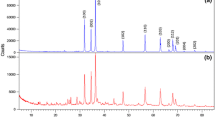Abstract
Chromium oxyhydroxide nanomaterials with narrow size-distribution were synthesised through a simple hydrothermal method. Experimental conditions, such as reaction duration and pH values of the precipitation process and hydrothermal treatment played important roles in determining the nature of the final product chromium oxyhydroxide nanomaterials. The effect of these synthesis parameters were studied with the assistance of X-ray diffraction, scanning electron microscopy, X-ray photoelectron spectroscopy and thermogravimetric analyses. This research has developed a controllable synthesis of Chromium oxyhydroxide nanomaterials from Chromium oxide colloids.






Similar content being viewed by others
References
Rotter H, Landau MV, Carrera M, Goldfarb D, Herskowitz M. High surface area chromia aerogel efficient catalyst and catalyst support for ethylacetate combustion. Appl Catal B Environ. 2004;47:111–26.
Rotter H, Landau MV, Herskowitz M. Combustion of chlorinated VOC on nanostructured chromia aerogel as catalyst and catalyst support. Environ Sci Technol. 2005;39:6845–50.
Nofz M, Sojref R, Feigl M, Dressler M, Doerfel I. Sol–gel alumina coatings for oxidation protection of high-temperature alloys. Part 2. Keramische Zeitschrift. 2009;61(272):274–7.
Yang X, Peng X, Xu C, Wang F. Electrochemical assembly of Ni–xCr–yAl nanocomposites with excellent high-temperature oxidation resistance. J Electrochem Soc. 2009;156:C167–75.
Fujikawa J, Hata M, Kokaji K. Direct-current reactive sputtering for metal compound thin film without unreacted metal particles. Otsu: Nippon Electric Glass Co. Ltd.; 1998. p. 5.
Shigeta K, Goto K. Electron emitters having layers with controlled perpendicular and horizontal resistivity. Tokyo: Toray Industries Inc.; 2009. p. 10.
Abecassis-Wolfovich M, Rotter H, Landau MV, Korin E, Erenburg AI, Mogilyansky D, Garshtein E. Texture of chromia aerogels and structure of their nanocrystals. Stud Surf Sci Catal. 2003;146:247–50.
Bai Y-L, Xu H-B, Zhang Y, Li Z-H. Reductive conversion of hexavalent in the preparation of ultra-fine chromia powder. J Phys Chem Solids. 2006;67:2589–95.
Landau MV, Shter GE, Titelman L, Gelman V, Rotter H, Grader GS, Herskowitz M. Alumina foam coated with nanostructured chromia aerogel: efficient catalytic material for complete combustion of chlorinated VOC. Ind Eng Chem Res. 2006;45:7462–9.
Simonova LA, Smyshlyaev SI, Tsymbal EP. Thermal stability and kinetics of the dehydration of amorphous hydroxide. Izvestiya Vysshikh Uchebnykh Zavedenii Khimiya i Khimicheskaya Tekhnologiya. 1973;16:334–7.
Erenburg A, Gartstein E, Landau M. Structural characterization of nanocrystalline CrOOH·2H2O aerogel by X-ray diffraction. J Phys Chem Solids. 2005;66:81–90.
Cheng H, Liu Q, Yang J, Zhang Q, Frost RL. Thermal behavior and decomposition of kaolinite–potassium acetate intercalation composite. Thermochim Acta. 2010;503–504:16–20.
Yang J, Frost RL, Martens WN. Thermogravimetric analysis and hot-stage Raman spectroscopy of cubic indium hydroxide. J Therm Anal Calorim. 2010;100:109–16.
Yang J, Liu H, Martens WN, Frost RL. Synthesis and characterization of cobalt hydroxide cobalt oxyhydroxide, and cobalt oxide nanodiscs. J Phys Chem C. 2010;114:111–9.
Zhao Y, Yang J, Frost RL. Raman spectroscopy of the transition of α-gallium oxyhydroxide to β-gallium oxide nanorods. J Raman Spectrosc. 2008;39:1327–31.
Bai Y-L, Xu H-B, Zhang Y, Li Z-H. Application of FTIR and XPS technique to the analysis of the mixture containing in a low valence state. Guangpuxue Yu Guangpu Fenxi. 2007;27:675–8.
Moffat TP, Latanision RM. An electrochemical and X-ray photoelectron spectroscopy study of the passive state of . J Electrochem Soc. 1992;139:1869–79.
Ratnasamy P, Leonard AJ. Structural evolution of chromia. J Phys Chem. 1972;76:1838–43.
Acknowledgements
The financial and infrastructure support of the Queensland University of Technology Chemistry Discipline is gratefully acknowledged. The Australian Research Council (ARC) is thanked for funding the instrumentation. One of the authors (JY) is grateful to the Queensland University of Technology Chemistry Discipline for the award of an international doctoral scholarship/QUT Write-up scholarship. This study was supported by the Hungarian Ministry of Culture and Education under Grant no. TÁMOP-4.2.2-08/1/2008-0018. The financial and infrastructural support of the State of Hungary and the European Union in the frame of the TÁMOP-4.2.1/B-09/1/KONV-2010-0003 project is gratefully acknowledged.
Author information
Authors and Affiliations
Corresponding author
Rights and permissions
About this article
Cite this article
Yang, J., Tao, Q., Frost, R.L. et al. Studies on self-assembly hydrothermal fabrication and thermal stability of Chromium oxyhydroxide nanomaterials synthesised from Chromium oxide colloids. J Therm Anal Calorim 111, 329–334 (2013). https://doi.org/10.1007/s10973-012-2262-1
Received:
Accepted:
Published:
Issue Date:
DOI: https://doi.org/10.1007/s10973-012-2262-1




